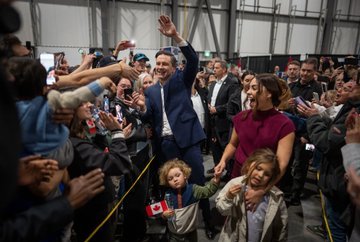He’s drawing crowds that rival rock concerts and filling arenas faster than tickets to a Taylor Swift tour. But as Pierre Poilievre rides a wave of massive rallies across Canada, political analysts are raising a pressing question; Do big crowds really translate into big wins at the ballot box?
In a political season defined by economic anxiety, culture wars, and calls for change, Canada’s Conservative Party leader Pierre Poilievre is generating momentum that appears to defy conventional norms. At a recent rally in Edmonton, his team claimed attendance soared to nearly 15,000 people, a turnout rarely seen in Canadian politics. Poilievre beamed with confidence, using the occasion not just to engage the crowd, but to flip the script on the media. Before a journalist could even pose her question, Poilievre asked her what she thought of the event. It’s a strategy he’s employed before, leaning into the size and energy of his rallies as a measure of grassroots strength. “This is a movement like we’ve never seen,” he declared. “People want change. They want to put our country first for a change.”

But while the optics are compelling, seasoned political analysts are urging the public and the media to look beyond the spectacle. Experts warn that equating massive rallies with electoral momentum can be misleading. “Crowd sizes are not a good measure of political support,” says Nathaniel Rakich, a prominent elections analyst formerly with FiveThirtyEight. “Polls are scientific. Crowd sizes are not. They don’t reflect the full voter base, just the most energized sliver of it.”
Rakich isn’t alone. The Crowd Counting Consortium, a collaboration between Harvard and the University of Connecticut, has tracked political events in the U.S. and found that larger crowds don’t necessarily mean electoral wins. In the 2024 U.S. presidential race, Kamala Harris pulled crowds of over 13,000 per event, nearly three times larger than Donald Trump’s average rally, yet Harris ultimately lost.

According to the data, large crowds often reflect enthusiasm, not broad support. And they rarely include the most important voters of all, the undecided and moderate swing voters who consistently decide elections.
Éric Grenier, founder of The Writ and a leading Canadian elections analyst, says while Poilievre’s crowd numbers show strong organizational strength, they don’t guarantee votes. “It’s the people that don’t attend rallies who end up deciding elections,” he says. “Even if you add up everyone attending these events, it still only represents around 1% of likely Conservative voters.” That other 99%? They’re watching quietly, forming opinions, and weighing options. And many of them, Grenier adds, may not be drawn in by the spectacle, they’re focused on policy, leadership temperament, and long-term stability.
Poilievre’s approach, energetic, confrontational, and populist, is effective at stirring passions. His campaign positions him as a champion of the working class, a disruptor of bureaucracy, and a defender of Canadian values. But his critics argue the excitement could become an echo chamber. Political strategist Ian Brodie, who served under former Prime Minister Stephen Harper, recently pointed out that crowd size can be deceiving. “If you’ve never been on a national campaign, it’s easy to believe that crowd size at a rally has any influence over anything,” he posted on X. And history backs him up. In 1979, Pierre Trudeau; a political titan, drew over 20,000 supporters to Toronto’s Maple Leaf Gardens just weeks before losing the election to Joe Clark.
The reality of 21st-century political campaigns is that optics can create media buzz, social media virality, and even fundraising spikes. But actual voting behavior is rooted in data, polling, and policy resonance. Still, no one can deny the potential impact of Poilievre’s campaign machine. Drawing 10,000 to 15,000 people to a single event in a country with historically low rally turnouts signals significant engagement, something many modern campaigns struggle to inspire. The question now is whether that engagement can be broadened, from energizing the base to capturing the center.
Poilievre’s rallies are a test, not of popularity alone, but of his campaign’s ability to turn excitement into votes. Can his message appeal to the undecided? Will he evolve from opposition figure to national leader? And most crucially; is the political energy real, or a reflection of digital-age optics?


